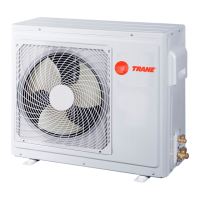Notice
For new installations, use the standard pipe sizes. When using existiong pipes, size-up is allowed as mentioned
in the table above. Additional restrictions towards allowable pipe lengths, as mentioned in the table 7.3 on page
13, must be taken into account.
Not using the standard lpipe size may result in capacity decrease. The installer must acknowledge this and judge
this very carefully in function of the complete installation.
Existing or pre-installed piping can be used
1 . Piping must comply with the criteria below .
Piping diameter must comply with the limitations as indicated in paragraph “7 .2 . Refrigerant pipe size “ .
Piping length must be withinlimits of the allowable piping length as in paragraph “7 .3 . Allowable pipe
length and height difference” .
Piping must be designed for R410A . See paragraph “6 .2 . Selection of piping material” .
2 . Piping can be reused without cleaning when:
Total 1-way piping length: < 50m .
No compressor breakdown has occurred in the history of the unit to be replaced .
A correct pump down operation can be executed:
- Operate the unit continuously for 30minutes in cooling mode .
- Execute a pump down operation .
- Remove the air conditioning units to be replaced .
Check the contamination inside the existing piping . If you cannot meet all these requirements, the existing
pipes must be cleaned or replaced after removing the air conditioning units to be replaced .
3 . Prepare the flare connections for higher pressure . See paragraph 6 .2
Cautions on handling the stem cap
The stem cap is sealed where indicated by the arrow . Take care not to damage it .
After handling the stop valve, make sure tighten the stem cap securely . For the tightening torque, refer to the table
below .
Check for refrigerant leaks after tightening the stem cap .
Cautions on handling the service port
Always use a charge hose equipped with a valve depressor pin, since the service port is a Schrader type valve .
After handling the service port, make sure to tighten the service port cap securely . For the tightening torque,
refer to the table below .
Check for refrigerant leaks after tightening the service port cap .
107

